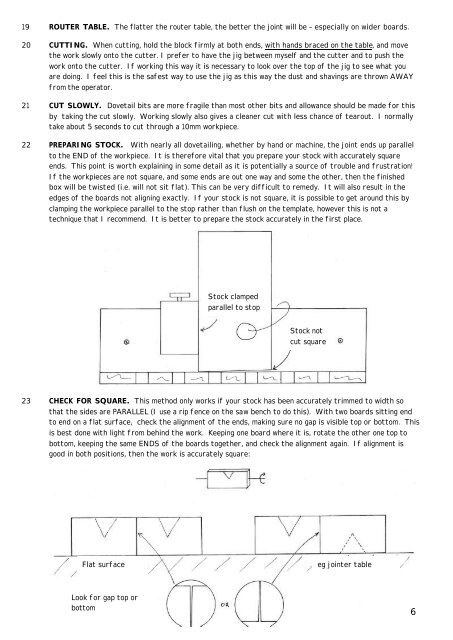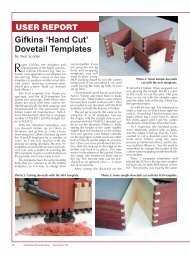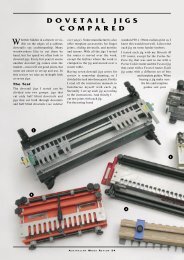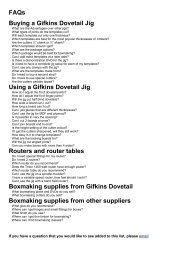Instructions for web - Gifkins Dovetail Jig
Instructions for web - Gifkins Dovetail Jig
Instructions for web - Gifkins Dovetail Jig
You also want an ePaper? Increase the reach of your titles
YUMPU automatically turns print PDFs into web optimized ePapers that Google loves.
19 ROUTER TABLE. The flatter the router table, the better the joint will be – especially on wider boards.<br />
20 CUTTING. When cutting, hold the block firmly at both ends, with hands braced on the table, and move<br />
the work slowly onto the cutter. I prefer to have the jig between myself and the cutter and to push the<br />
work onto the cutter. If working this way it is necessary to look over the top of the jig to see what you<br />
are doing. I feel this is the safest way to use the jig as this way the dust and shavings are thrown AWAY<br />
from the operator.<br />
21 CUT SLOWLY. <strong>Dovetail</strong> bits are more fragile than most other bits and allowance should be made <strong>for</strong> this<br />
by taking the cut slowly. Working slowly also gives a cleaner cut with less chance of tearout. I normally<br />
take about 5 seconds to cut through a 10mm workpiece.<br />
22 PREPARING STOCK. With nearly all dovetailing, whether by hand or machine, the joint ends up parallel<br />
to the END of the workpiece. It is there<strong>for</strong>e vital that you prepare your stock with accurately square<br />
ends. This point is worth explaining in some detail as it is potentially a source of trouble and frustration!<br />
If the workpieces are not square, and some ends are out one way and some the other, then the finished<br />
box will be twisted (i.e. will not sit flat). This can be very difficult to remedy. It will also result in the<br />
edges of the boards not aligning exactly. If your stock is not square, it is possible to get around this by<br />
clamping the workpiece parallel to the stop rather than flush on the template, however this is not a<br />
technique that I recommend. It is better to prepare the stock accurately in the first place.<br />
23 CHECK FOR SQUARE. This method only works if your stock has been accurately trimmed to width so<br />
that the sides are PARALLEL (I use a rip fence on the saw bench to do this). With two boards sitting end<br />
to end on a flat surface, check the alignment of the ends, making sure no gap is visible top or bottom. This<br />
is best done with light from behind the work. Keeping one board where it is, rotate the other one top to<br />
bottom, keeping the same ENDS of the boards together, and check the alignment again. If alignment is<br />
good in both positions, then the work is accurately square:<br />
Flat surface eg jointer table<br />
Look <strong>for</strong> gap top or<br />
bottom<br />
Stock clamped<br />
parallel to stop<br />
Stock not<br />
cut square<br />
6







